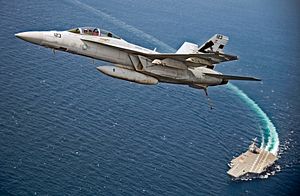The nuclear-powered aircraft carrier USS Gerald R. Ford (CVN-78), the lead of vessel of the U.S. Navy’s latest class of carriers, suffered a previously undisclosed failure at sea in January 2018 that forced the warship to return to port, according to a report by Bloomberg News.
The failure reportedly pertained to the ship’s propulsion system bearing and has so far not been fixed. According to the report, it was the second failure of the so-called main thrust bearing of the Ford-class carrier’s propulsion system. The first incident occurred in April 2017.
Based on information supplied by the U.S. Navy’s Naval Sea Systems Command, the agency responsible for the design, construction, and maintenance of the service’s fleet of ships and combat systems, the USS Gerald R. Ford experienced “an out of specification condition,” which was due to a “manufacturing defect,” and “not improper operation.”
General Electric Co., the subcontractor responsible for the propulsion system part that failed, said that an investigation revealed “machining errors” by company workers “during the original manufacturing” as “the actual root cause.” A spokesperson of the company said that the defect will “be fully corrected.”
News of the failure of parts of the Ford’s propulsion system come at a time when the U.S. Navy is considering procuring two rather than one nuclear-powered Gerald R. Ford-class aircraft carrier in a single buy, as I wrote in March:
The U.S. Navy intends to operate a fleet of 12 Ford-class carriers, up from the 11 Nimitz-class currently in service, by the end of the 2030s. Should all criteria be met, a two-ship buy contract is expected to be awarded in early 2019, pending congressional approval. Yet the dual-buy procurement will only occur if HII-NNS [Huntington Ingalls Industries – Newport News Shipbuilding] demonstrates a significant reduction in labor and material costs.
Ordering two carriers in one go is expected to reduce overall cost and the time it will take to deliver the warships to the Navy. The recently revealed failure thus comes at an inopportune time for HII-NNS and its subcontractor. As I reported previously, due to time constraints as a result of multiyear delays, the service considered cancelling shock trials, a move that was calculated to move up the combat deployment of the Ford by a year from 2022 to 2021. As I wrote previously:
Controlling the cost of the Ford-class program has been a big challenge for the U.S. Navy, with cost overruns around $2.3. billions so far. The first-of-class USS Gerald R. Ford (CVN-78), commissioned in July 2017, is already the U.S. Navy’s most expensive warship in its history, with total cost amounting to almost $13 billion. The per-unit cost of the remaining ships of the class is estimated at around $10 billion. The Ford’s follow-on, the future USS John F. Kennedy CVN-79), will likely be commissioned in 2020.
Excessive costs are partially the result of the many new systems to be found on the new carrier class:
The USS Gerald R. Ford, commissioned in July 2017, is equipped with a host of new and untested technologies, including the carrier’s two main turbine generators, a new dual-band radar system, advanced weapons elevators, and a new advanced arresting gear on the flight deck. (U.S. President Donald Trump objected to the installation of some of the new systems such as General Dynamics’ new electromagnetic aircraft launch system aboard, as I reported in May 2017.) It is precisely the reliability of these new systems that the Pentagon wants to thoroughly test.
The failure of the ship’s propulsion system bearing is expected to be fixed by the end of the Ford’s so-called post-shakedown availability phase, a period used to address technical deficiencies found after extensive sea trials by the service.
































